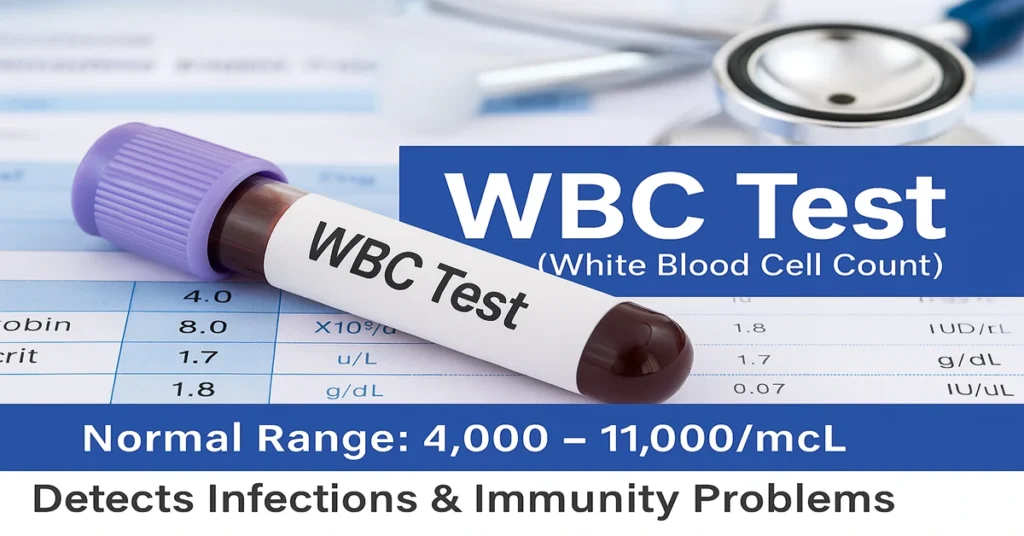What is the WBC Test?
The WBC Test (White Blood Cell Count Test) measures the number of white blood cells in your blood. White blood cells are a vital part of the immune system. They fight infections caused by bacteria, viruses, fungi, and parasites.
This test is part of the Complete Blood Count (CBC) and helps doctors detect infections, inflammation, immune disorders, and blood cancers.
Where Are WBCs Synthesized/Produced in the Body?
White blood cells are produced in the bone marrow. Some also mature in lymphatic organs such as the thymus, lymph nodes, and spleen.
Different types of WBCs include:
- Neutrophils: First line of defense against bacteria.
- Lymphocytes: Include B cells (make antibodies) and T cells (kill infected cells).
- Monocytes: Help with tissue repair and long-term defense.
- Eosinophils: Fight parasites and are active in allergies.
- Basophils: Release histamine during allergic reactions.
Main Functions and Importance of WBCs
- Fight Infections: Destroy harmful bacteria, viruses, fungi, and parasites.
- Immune Memory: Remember past infections for faster defense.
- Inflammation & Healing: Control tissue repair and wound healing.
- Allergy Response: Eosinophils and basophils react in allergies.
- Cancer Surveillance: Detect and destroy abnormal or cancerous cells.
Causes of Low WBC Count (Leukopenia)
- Viral infections: HIV, hepatitis, flu
- Bone marrow suppression: aplastic anemia, chemotherapy, radiation
- Autoimmune diseases: lupus, rheumatoid arthritis
- Severe overwhelming infections
- Medications: immunosuppressants, antibiotics, antipsychotics
- Nutrient deficiencies: vitamin B12, folate, copper
- Blood cancers: leukemia, myelodysplastic syndrome
Symptoms of Low WBC Count
- Frequent or recurring infections
- Fever, chills
- Mouth ulcers or sore throat
- Weak immune system
- Fatigue
- Slow wound healing
Causes of High WBC Count (Leukocytosis)
- Bacterial infections (pneumonia, tonsillitis)
- Stress, surgery, or physical trauma
- Inflammatory conditions: rheumatoid arthritis, IBD
- Allergic reactions or asthma
- Blood cancers: leukemia, lymphoma
- Tissue damage: burns, heart attack
- Smoking
- Pregnancy or labor (temporary rise)
Symptoms of High WBC Count
- Often no direct symptoms
- Symptoms depend on underlying cause (e.g., fever with infection)
- Swollen lymph nodes
- Body pain or inflammation
- Fatigue
- In leukemia: repeated infections, bleeding, night sweats
Reference Ranges
(may vary slightly by lab)
Normal WBC Count: 4,000 – 11,000 cells per microliter (mcL)
Low WBC (< 4,000/mcL): Leukopenia
High WBC (> 11,000/mcL): Leukocytosis
Sample Type
- Sample Taken: Whole blood
- Tube Used: Lavender-top EDTA tube
Test Preparation
- Usually no fasting is required.
- Inform your doctor if you are on steroids, antibiotics, or chemotherapy, as they affect WBC count.
- Avoid strenuous exercise just before the test (may cause temporary WBC rise).
- Stay hydrated before the test.
When to Consult a Doctor
- If you have frequent unexplained infections.
- If you experience fever, chills, or swollen lymph nodes.
- If your CBC report shows WBC counts consistently high or low.
- If you have family history of blood disorders or cancers.
~END~

